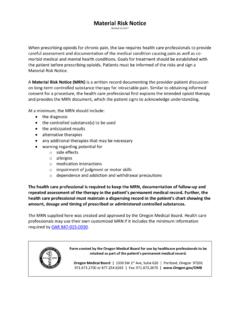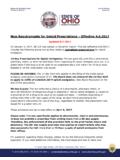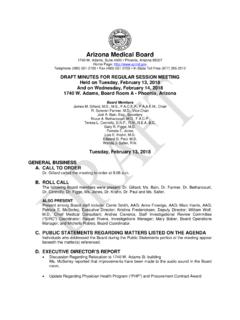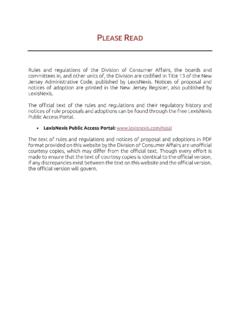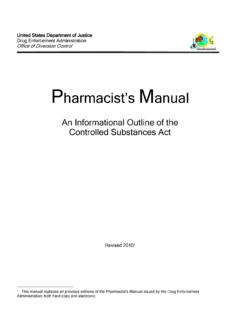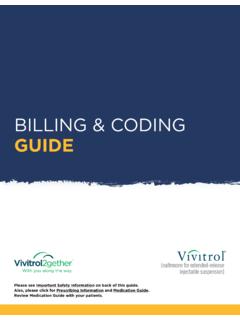Transcription of Advancing Pain Management in Oregon
1 Advancing Pain Management in Oregon The Oregon Pain Management Commission (OPMC) This online educational module qualifies as the required 1 (one) hour continuing education for pain Management in Oregon . Additionally, all health care providers (with the exception of dentists) are required to select and complete an additional 6 (six) hours of continuing education related to pain and/or pain Management in their area of interest. Introduction: The Oregon Pain Management Commission s goal is to offer education to improve understanding of pain and its treatment. Inadequate pain treatment, over-reliance on medications for pain Management and lack of knowledge/support of biopsychosocial-informed pain self- Management treatments are serious public health problems.
2 This module is intended to provide a foundation for Advancing pain Management in Oregon and to increase awareness regarding evidence-based treatments for the effective Management of pain. Pain treatment issues are complex and cannot be adequately addressed in this one-hour module. Information about additional expanded educational topics may be found on the Oregon Pain Management Commission s website. Providers may elect to address their specific interests/concerns related to the Management of pain in the individually selected 6 (six) hour continuing education curriculum requirement which is beyond the OPMC s purview.
3 Advancing Pain Management in Oregon | The Oregon Pain Management Commission 2 | P a g e The Oregon Pain Management Commission (OPMC) In 2001, the Oregon Legislature mandated the creation of a commission to focus on pain issues in Oregon . The OPMC is a 19 member advisory commission within the Oregon Health Authority. Its members are an interdisciplinary group of physicians (medical, naturopathic, osteopathic, chiropractic), physician assistants, nurse practitioners, dentists, pharmacists, nurses, psychologists, acupuncturists, physical therapists, occupational therapists, patient advocates, healthcare consumers and other interested individuals.
4 In addition, two members from the Oregon Legislature a member of the Senate and a member of the House of Representatives serve as non-voting (ex officio) members. Among the Commission s tasks is to develop requirements for pain Management education for Oregon physicians and other healthcare licensees of the regulatory boards. Its mission is to improve pain Management in the State of Oregon through education and development of pain Management recommendations. The OPMC represents the concerns of patients in Oregon on issues of pain Management to the Governor and the Legislative Assembly. This online pain Management education module is updated biennially.
5 Although there are many challenges to achieving adequate pain Management for all Oregonians, the OPMC has a vision for pain care in Oregon . We believe that adequate pain Management can be realized if there is effective collaboration and communication between regulatory agencies, healthcare providers, insurers and patients. Evidence-based pain Management services should be as equally available as services for other common conditions or disease states of similar prevalence and health impact. The availability and quality of pain Management resources should meet the needs of patients in our state. Advancing Pain Management in Oregon | The Oregon Pain Management Commission 3 | P a g e A Call for Cultural Transformation: The economic and social impacts of pain are thought to be greater than for any other single disease entity.
6 In the past pain was described on the basis of duration and evidence of healing. Definitions simply referred to pain as a physical symptom of illness or injury based on a stimulus response mechanism. Medical treatment focused on pharmacological Management of physical symptoms and all pain was managed as acute. Persistent, untreatable pain was believed to be psychosomatic in a pejorative sense; patients were not believed or were thought to be malingering for some gain. The economic impact of pain is significant. Pain is a leading reason patients seek medical care. A 2011 Institute of Medicine report1 indicated chronic pain costs the nation up to $635 billion each year in medical treatment and lost productivity.
7 Chronic pain is a major public health problem because it affects millions of individuals, their families, and the healthcare system. It negatively affects lifestyle, function, self-efficacy, independence and psychosocial well-being. Chronic pain can cause loss of meaningful occupation, disruptions in family, work, and social relationships, and contributes to needless suffering and risks of suicide. To prevent acute pain from transitioning to persistent (chronic) pain, appropriate and effective treatment of acute pain is vital. The treatment of acute pain must include biopsychosocial considerations. See Figure 1. Additionally, a new pathway to our approach in the Management of pain must be considered.
8 According to Jane C. Ballantyne, University of Washington, the cultural transformation needed is demedicalization of the most common pain conditions . See Figure 2. 1 Relieving Pain in America: A Blueprint for Transforming, Prevention, Care, Education, and Research, 2011: Institute of Medicine (IOM) Advancing Pain Management in Oregon | The Oregon Pain Management Commission 4 | P a g e Figure 1: Biopsychosocial Model of Pain Championed by Butler and Moseley and others, 2000. Figure 2: Courtesy of Jane C. Ballantyne, University of Washington, Seattle; Presentation: The evolution of the science of chronic pain: from the gate theory to central sensitization, May 20, 2016 OLD PATHWAY NEW PATHWAY Advancing Pain Management in Oregon | The Oregon Pain Management Commission 5 | P a g e How did we get here?
9 Neurobiology and underlying behavioral health issues associated with pain had limited understanding. Healthcare reimbursement systems discouraged interdisciplinary practices to treat chronic pain. In 1980, a single paragraph written by J. Porter and H. Jick of Boston University Medical Center was published in the New England Journal of Medicine as a Letter to the Editor citing their review of patient files for the incidence of narcotic addiction in hospitalized patients. They concluded the development of addiction was rare in patients treated with narcotics2. In 1995, the president of the American Pain Society introduced a campaign entitled Pain is the Fifth Vital Sign at the society s annual meeting which encouraged health care professionals to more aggressively treat pain similar to heart rate and blood pressure.
10 The pharmaceutical industry began promoting the use of opioid medications to treat chronic non-cancer pain as a means to address a newly defined pain crisis. By 2010, enough opioid pain relievers were sold to medicate every American adult with a typical dose of 5 mg of hydrocodone every 4 hours for 1 month3. When it comes to pain relief from opioids a significant gap exists between a patient s expectation and reality. In 2004 The American Journal of Emergency Medicine published a study4 that assessed patient expectations for pain relief in the emergency room and found that patients often expect 75% of their pain to be relieved with opioids.









